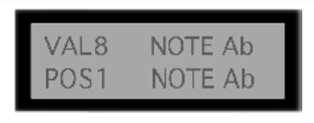Analogue Systems
The Programmable Scale Generator exceeds the possibilities of an ordinary quantiser module.
The Programmable Scale Generator exceeds the possibilities of an ordinary quantiser module.
While a quantiser usually is chromatic only and with a little luck it allows major and minor scales, a programmable scale generator like the RS-130 makes it possible to freely program scales beyond the customary semitone scale with all their derivates.
Scales with quarter-note or eighth-note intervals are possbile which is important e.g. for indian or oriental music.
Two modes determine when quantisation takes place: in "free run" it happens only when input voltage changes. In "gate" mode quantisation happens when the RS-130 receives a gate signal.
PROGRAMMING THE USER MEMORY
Use the MODE button to select the Quantiser mode.
Now use an external voltage source connected to either of the V-IN sockets, or use the OFFSET control, to select the notes in the desired scale, as follows :
Starting from the bottom of the range, you should sweep slowly upwards through the chromatic scale.
Then, each time the display shows one of the notes that you wis h to includ e in the scale, press RECORD.
For example, if you have decided that the first note in your scale is to be the Ab in the lowest octave, the RS-130 screen will look like this:

The four parts of the screen show:
- VAL: The note value, where C0 is note VAL=0
- NOTE: The note name, in this case Ab
- POS: The position of the note in the programmable scale
- NOTE: The note stored in POS1
If this duplication of note information seems odd, it makes more sense when you choose the next note in the scale. Let's say that the next note is to be Eb in the octave above the first note. The screen will now look like this:

The four statements now show:
- VAL: The new note value, where C0 is note 0
- NOTE: The new note name, in this case Eb+1
- POS: The position of the previous note in the programmable scale
- NOTE: The note in the previous position.
The two NOTE names now allow you to see the previous note in the scale, plus the current note. This makes it simpler to see how your scale is developing.
If you now press RECORD, the screen will change to show that NOTE Eb+1 is stored in POSITION 2.
When you have incorporated all the notes you require, press SAVE to store the scale into the single User Memory. This memory in non-volatile, and it will retain your scale even when the power to the Integrator is removed.
Note 1: Do not RECORD the same note twice. It will confuse the PSG and lead to unpredictable results.
Note 2: Always RECORD your scale in one direction. Do not alternate between "up" and "down" when selecting the notes. To do so will cause problems when User Memory Mode is selected and you try to use the scale.
If you use the OFFSET control to program a scale you will be limited to the 2 octave range it offers. If you wish to use the full 5 octave range of the RS-130 you must use a 0V to +5V CV source from another module.
To replace an existing scale, simply return to Quantiser mode and repeat the exercise.

